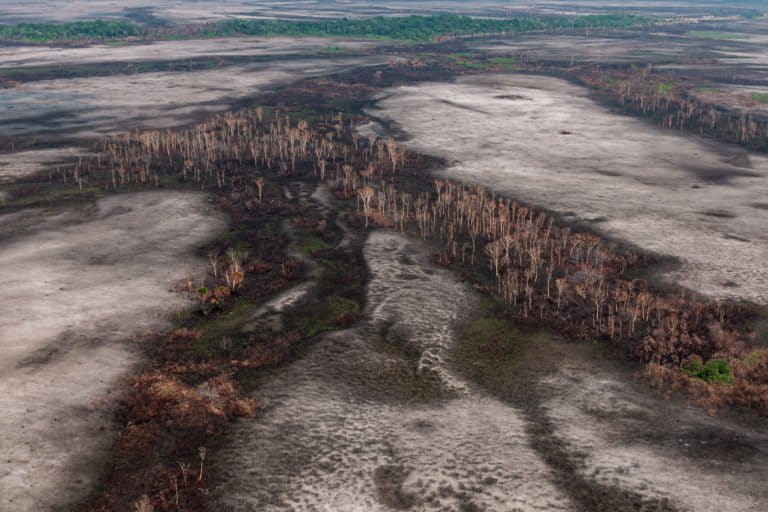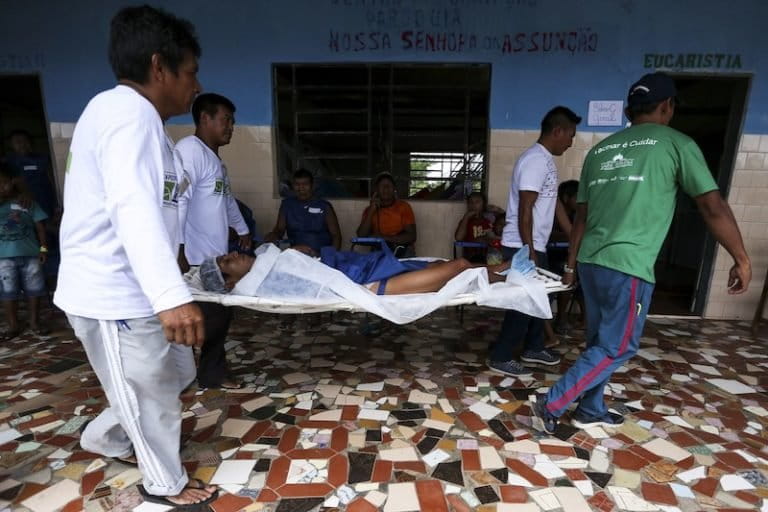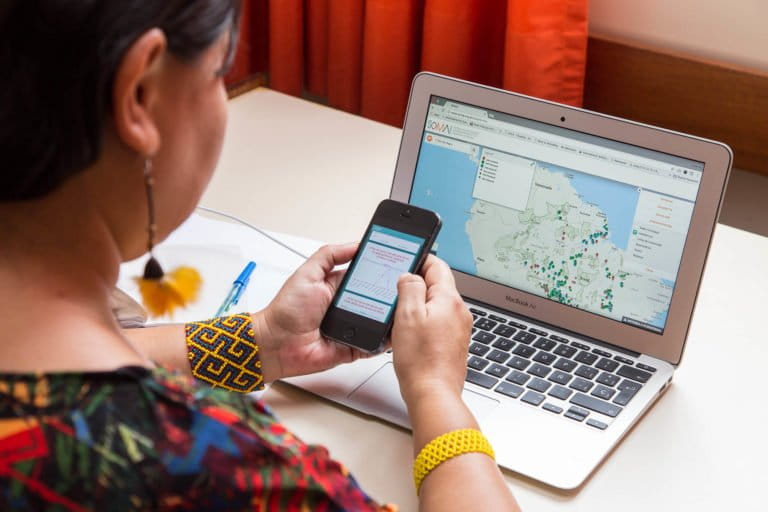- Late rainfall, intense drought, dry riverbeds, more forest fires, less food available — indigenous communities across the Brazilian Amazon suffer social transformations due to climate change.
- Indigenous people believe that climate change has even affected their physical health: previously controlled diseases like measles and yellow fever, they say, have inexplicably reappeared in the rainforest, and even indigenous women’s menstrual cycles are beginning at an earlier age.
- Indigenous people have found many ways to take action and lessen the harm. These approaches include selecting and growing seeds that are more resistant to drought and heat, investing in frontline firefighters and even a smartphone app that offers information about climatic variations.
In the Bico do Papagaio region, north of Tocantins state, Antonio Veríssimo Apinajé recalls his life as a boy in the Taquari village, in the 1970s. “It would rain non-stop for three or four days in a row, from January to June. The rivers and springs filled up. The rainy season used to begin in October, when my family planted manioc, corn and rice. In June, the dry season would come, which lasted until September.”
Not anymore, says the leader of the Apinajé indigenous people. “There are years in which the rains take a long time to come, sometimes only in November, December, even January. Only then can we plant. In April, the rains are already stopping. If we don’t have water, we can’t irrigate [our crops]. The manioc is small, the corn doesn’t ‘swell’. Rainfall has diminished a lot over the last ten years.”
The Apinajé leader isn’t alone; indigenous Brazilians have been observing sweeping climate change impacts across the Amazon and other regions, and reporting how that transformation is affecting their daily lives. Many say that nature has been providing signs of a massive change in the weather for at least 15 years. And more dire, they say: things seem to be accelerating recently.
The scientific community, using satellites and other measures, is in agreement: recent studies show that the Amazon is drying out and has already reached, or is very close to reaching, a biome tipping point. At least half of the rainforest could become degraded savanna over the next 50 years, some researchers say, if global climatic change, Brazilian deforestation and Amazon fires aren’t greatly reduced. And, as indigenous people have noted, global warming of late is quickening its pace and may bring ecological collapse far more quickly than thought.

“When the water runs low, it is the first sign,” says Antonio Veríssimo. It means that the rains will be late — a factor that, together with intense and prolonged drought, ends up harming crops and reducing the variety of foods available in the villages. Once again, this is an observation with which scientists, Brazilian farmers and dam builders can concur.
Maria Leonice Tupari, head of AGIR, the Association of Indigenous Women Warriors of the state of Rondônia, says that in Sete de Setembro, the indigenous territory where she lives, “the river frequently dries up, and the water that is left forms a sort of bay where the fish try to survive. When the rains return, the [thermal] shock of the cold rainwater mixing with the warm river water kills the small fish.”
As if diminishing natural resources weren’t enough, Maria Leonice is also concerned with the reappearance of illnesses in local villages. “Diseases that had been controlled are coming back, like measles and yellow fever… I believe that this is related to the climate, to the destruction of nature. And then a virus came to show us how fragile we are, to make us reflect on things,” she says, referring to the arrival of COVID-19 inside indigenous villages. At mid-May, the virus had already infected over 500 indigenous people in Brazil. Scientists are in concurrence here as well, noting that humanity’s wholesale invasion of the Amazon and other tropical rainforests is increasing the risk of planetwide pandemics, and also yellow fever.
The increasingly hot climate may also be altering the bodies of Kiriri women in northeastern Bahia state, who reported the situation to Sinea do Vale, coordinator of the environment for CIR, the Roraima Indigenous Council. “The Kiriri women believe that the extreme heat is causing pre-menstrual tension to hit indigenous adolescents at an earlier age.” There is, in this case, no corresponding scientific proof of such an effect that Mongabay could locate in a search of the literature. However, a 2018 study did find that air pollution could cause “irregular menstrual cycles,” and it is plausible that soot particulates from record Amazon fires — worsened by climate change — could be causing the observed problem, though more study would be needed.

Climate change brings more fires, smoke affects villages
The combination of an increasingly hot and dry climate resulting in far more numerous and intense Amazon wildfires — especially as land grabbers clear more rainforest, or as farmers clear fields for planting — is also negatively impacting indigenous reserves, especially those located along the so-called “Arc of Deforestation” stretching from Rondônia state in the west of Brazil, to Pará state in the east.
Such is the case with the Sete de Setembro Indigenous Territory where Maria Leonice Tupari lives. It is the ancestral land of the Suruí Paiter people, along the border between Rondônia and Mato Grosso states. Today the reserve is surrounded by cattle ranches. “The farmers like to burn large swaths of land to clear pastures. Last year, any little thing could start a fire, from cigarette butts to glass bottles [intensifying sunlight on dry bush]. It was litter from trucks thrown into the dry grass alongside the roads,” that served as tinder, she reported.
According to the leader of the women warriors of Rondônia, fires gave rise to another serious problem in 2019, one of the worst years on record for forest fires in the Amazon: “The smoke from the fires made many people sick, suffering from strong headaches, eye irritation and respiratory problems. The smoke was terrible. Especially children and the elderly needed to be taken to regional hospitals, which were already full of people from the cities who had also been poisoned.” It is scientifically well documented that particulates from fires and other pollution are a major cause of death and disease globally, according to the World Health Organization.
Six hundred miles away, on the edge of the Rio Tocantins, Antonio Apinajé shares the same fear: “We get worried when there are fires in the region because, depending on the time of day and force of the wind, the fires can fly. We live near to the forest and the Cerrado vegetation; it is scary even to think about it. That heavy smoke stays in the air for two or three months,” says the Apinajé leader.
To reduce damage to Amazon and Cerrado biome vegetation, Brazil’s environmental agency, IBAMA under its National Forest Fire Prevention Combat Center (Prevfogo) hires indigenous people during fire season to act as firefighters on the indigenous lands where they live. “They know the territory better than anyone, they know where the vegetation most at risk from fire lies, where the fires tend to start and how they spread,” explains Prevfogo director Gabriel Constantino Zacharias.
The IBAMA initiative began in 2013 with 400 indigenous firefighters — a third of the total number of firefighters available at the time — and has grown over the years. But in 2019, under the Bolsonaro administration, numbers fell for the first time: there were 760 indigenous firefighters in the field in total, 20 fewer than in the previous year.
“The first year of an administration usually involves budget restrictions,” Zacharias said of Bolsonaro management policy. In August of last year, both Germany and Norway suspended contributions to the Amazon Fund because of increasing deforestation in Brazil. A portion of those funds annually financed the buying of firefighters’ clothes and boots. Between 2104 and 2018, the Fund invested US$4 million for Prevfogo activities in the nine Amazon states.

House of Seeds
In Tocantins, the Apinajé people are adapting to climate change by dedicating time to researching seeds that are more resistant to drought, high temperatures and shorter growing seasons.
“Instead of using rice that needs five or six months to mature, we are now planting a short duration variety that matures in only three months,” says Antonio Apinajé. “We also found a species of manioc that grows in seven months as compared to the one we planted before, which usually needed a year.”
The availability of water equally influences choices on what to plant, he says. “Manioc and beans don’t need much rain, but rice, pumpkins, corn and bananas do. That’s why we are planting less of those crops.”
A little over a year ago, the Apinajé people — 2,800 individuals spread among 42 villages inside the indigenous territory that carries their name — created the Seed House, a seed bank to store crop species that are most productive and resistant to heat. The Apinajé plan to broaden the collection’s variety via exchange of seeds and knowledge with other indigenous peoples, small-scale family farms, and traditional Afro-Brazilian communities.
The initiative has now been adopted in other Amazon states: in Roraima for example, leaders are forming a network of seed banks between various indigenous regions and territories. “The project is on hold because of COVID-19, but we will start up again as soon as possible,” said Sineia do Vale, representative of the Wapichana people on the Roraima Indigenous Council.
Last August, the council promoted the organization of a seed bank within the Raimundão Indigenous Territory in Alto Alegre municipality. It also promoted cultivation of more heat and drought resistant corn, manioc and pepper seeds on two hectares. These are the crops most consumed by local communities, and if the initial effort goes well, seeds could be distributed to other communities.
These actions are part of a pioneering environmental management plan attentive to the climate change factor, conceived after consulting inhabitants of the Malacacheta, Jacamim and Manoá-Pium Indigenous Territories.
Interviews were conducted by over 200 Indigenous Territorial and Environmental Agents (ATAIS, in Portuguese), leading to the publication of a book entitled Amazad Pana’adinhan — Indigenous Communities’ Perceptions on Climate Change — Serra da Lua Region, Roraima.
Disregarded by researchers until recent years, “ancestral knowledge is being discussed by scientists in many parts of the world to help understand climatic issues,” says the Wapichana leader.

Fighting fire with cell phones
A collaboration between scientific and indigenous knowledge has also led to the creation of technological tools, including the Indigenous Climate Alert. Developed by IPAM (the Amazon Environmental Research Institute), this app provides data on concentrations of heat, risk of drought and deforestation to help indigenous people monitor their territories and surrounding regions. The information can be accessed even when there is no cellphone connection.
Indigenous people can also use the app to share alerts about fires and illegal activity on their lands, including illegal deforestation, predatory fishing and wood extraction.
“On one hand, indigenous people play a huge role in mitigating climate change, but on the other, they live directly with [those changes] and are therefore the most affected,” says IPAM researcher Martha Fellows Dourado. “The Climate Alert arose as a tool to support territorial management inside indigenous territories at point zero — inside the communities themselves.”
The app is in use today in the states of Roraima, Maranhão and Mato Grosso, and the goal is for it to be available and utilized in all of Brazil’s demarcated indigenous reserves. In the next few months, the Indigenous Climate Alert will play a new role related to the COVID-19 pandemic; users will be able to follow the spread of the disease in villages and cities.
Beyond technology, Leonice Tupari invokes the spirituality of the forest-dwelling peoples as a way of adapting to the sweeping changes that seem to be coming: “We must respect nature and connect with her. We are spirits here on the Earth, incarnated as material, connected to fire, earth, wind — to all that exists. People have distanced themselves from her. They no longer walk on the earth, nor do they feel the breeze. We must feel water, and I’m not talking about the water that comes out of the shower. Our spirituality is connected with Nature.”

Banner image of a land devastated by the fire in a Huni Kuin community, state of Acre, in August 2019. Image courtesy of Centro de Cultura Indígena Huwã Karu Yuxibu.
This story was first reported by Mongabay’s Brazil team and published here on our Brazil site on May 14, 2019.














